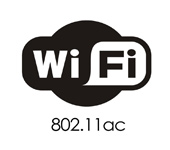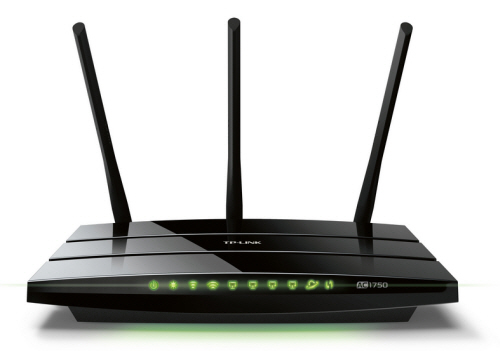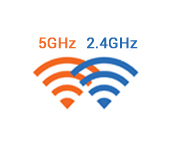802.11AC-New Wi-Fi Standard

The extraordinary growth in the volume and types of various wi-fi devices, coupled with the increasing popularity of high-definition video streaming, is creating a demand for better and higher performing technologies. The 802.11ac communication standard is a new wi-fi standard that is designed to meet these needs.
The new communication standard gives the ability to greatly expand network bandwidth, from 430 Mbps (devices at 433 Mbps per channel were already available in 2014) to a maximum speed of 6.77 Gbps with 8x MU-MIMO antennas. This is the most significant innovation in this area relative to IEEE 802.11n. In addition, it is expected to reduce power consumption (J/bit), which in turn will increase the independent operation time of all mobile devices.
Read more about IEEE 802ac Wi-Fi technology:
For the first point of reference in the history of 802.11ac can be considered the beginning of 2011, at the time when the Institute of Electronics Engineers (IEEE) took the first draft of the next “version” of wi-fi. And six months later, Quantenna threw on the market the first such chipset, which is perfectly compatible with routers as well as commercial devices. Another important milestone in the development of high-speed Wi-Fi can be taken as the 2014 CES show. At this exhibition, new controllers were announced by a major chip manufacturer Broadcom, while the following companies decided to implement them in their own products: Lenovo, ZTE, Huawei, Comcast, as well as other well-known players in the modern electronics market.
What is the difference between the new 802.11ac standard and the more common today 802.11n?
- The most important difference is that the updated Wi-Fi standard offers many times higher data transfer speeds (1.3 gigabits in theory), which will favorably affect media streaming (especially HD video), mobile applications and data transfer. The 802.11n standard guarantees maximum data rates of 150 Mbps from 1 antenna, 300 from 2 antennas and 450 from 3 antennas. The 802.11ac standard is several orders of magnitude higher: 450/900 and 1.3 Gbps. Also, the speed of 802.11ac-compatible devices with 8 antennas at once can reach 6-7 Gbps.
- Another advantage of the new Wi-Fi standard is an even wider network coverage range and a stronger and more stable signal, which makes it possible to cover an apartment using only one router. These improvements have been achieved through the use of beamforming technology (called “bimforming”) – which is able to recognize the location of the installed device and bounces the Wi-Fi signal directly to this device.
- Electronics with “legacy” Wi-Fi operate mostly on the heavily populated 2.4 GHz frequency, sharing it with nearby microwave and other appliances. Consequently, another advantage of 802.11ac is that it eliminates interference by operating on the 5 GHz band.
- The process of transition to 802.11ac standard will last for several years, so the devices and appliances working on the new Wi-Fi standard are planned to support backward compatibility with older standards. You won’t have to throw out your router after buying a new device: if necessary, they will be able to automatically switch from pure 5 GHz to 2.4.
802.11ac in practice. WiGig and LTE-A and SG
As expected, the Wi-Fi and IEEE Alliance approved the new specification by the end of 2014. This year, 2015, experts say at least one billion devices will be compatible with the new technology. However, you won’t have to wait long: all commercial solutions that support ultrafast, gigabit wi-fi already exist on the market.  This includes the MacBook laptop released in 2013 and AirPort Extreme, Galaxy S4 smartphones running on Broadcom chips (BCM4435), ASUS G75VW series of laptops, Toshiba EXCITE tablet, as well as a large number of routers from Tp-Link, Asus, D-Link, Belkin, etc.
This includes the MacBook laptop released in 2013 and AirPort Extreme, Galaxy S4 smartphones running on Broadcom chips (BCM4435), ASUS G75VW series of laptops, Toshiba EXCITE tablet, as well as a large number of routers from Tp-Link, Asus, D-Link, Belkin, etc.
Affordability:
Even though the official ratification of the new 802.11ac standard is far away and ISPs are not yet ready to give the necessary speeds, physically the new Wi-Fi is available now. Ordinary users can already benefit from the new standard by streaming their “streaming” HD video to multiple devices within a local network, synchronizing “large” files (using Time Capsule, for example). But, such routers are quite expensive – from 200 dollars, and 802.11ac-compatible devices are still too few.
WiGig:
Together with 802.11ac, another promising standard is being developed – 802.11ad (called – WiGig). Compared to 802.11ac, this technology operates at an even higher frequency (60 GHz), and this prevents the signal from passing through walls. This specification can be called “USB without wires” rather than a successor to wi-fi, since WiGig can only connect devices that are close to each other (within a few meters). But despite its “short-sightedness”, WiGig guarantees speeds of up to 7 gigabits per second, i.e. almost 50 times higher than 802.11n. The standard’s applications include connecting external hard disks, connecting monitors and other peripherals, and transferring large files and data, such as uncompressed HD video.
LTE-A and SG:
Network development for cell phones is also moving forward. In the spring, Samsung talked about the creation of a technology that is supposed to be the foundation in the transmission of a 5th generation (5G) mobile network. The transmitter made by the company showed speeds of more than 1 Gbps at distances of up to 2 kilometers. In reality, this result means that an HD video can be downloaded to a tablet or smartphone in half a second and a movie in ten seconds. However, despite the achievement, it will not be possible to use 5G networks for a long time – not earlier than 2020.
And a few more words about IEEE 802.11ac
802.11ac is no longer some bright tomorrow, but a done deal today, with its advantages (reliability, speed) and some disadvantages. All that’s left is to wait a little longer. The question on many people’s minds right now is: is 802.11ac worth the switch, what can we expect from it in everyday use, and how is it better than 802.11n? I don’t think you should rush into it just yet. Well, you buy a router that supports 802.11ac, and what’s the use of it if most likely all the devices you will be connecting to will be 802.11n compliant. It is better to buy a normal, expensive router of 802.11n standard, which will work stably and at a frequency of 5Gh.
Eventually, everyone will switch to the new standard. When 802.11n appeared, everyone was also talking about the uselessness of the new standard.


 What is a Two-Band Wi-Fi Router (Dual-Band Wi-Fi)?
What is a Two-Band Wi-Fi Router (Dual-Band Wi-Fi)?  What is Miracast? ABOUT MIRACAST Technology on Mobile devices and TVS
What is Miracast? ABOUT MIRACAST Technology on Mobile devices and TVS  Dlna Technology. Using Dlna on Smart TVs and Other Devices
Dlna Technology. Using Dlna on Smart TVs and Other Devices